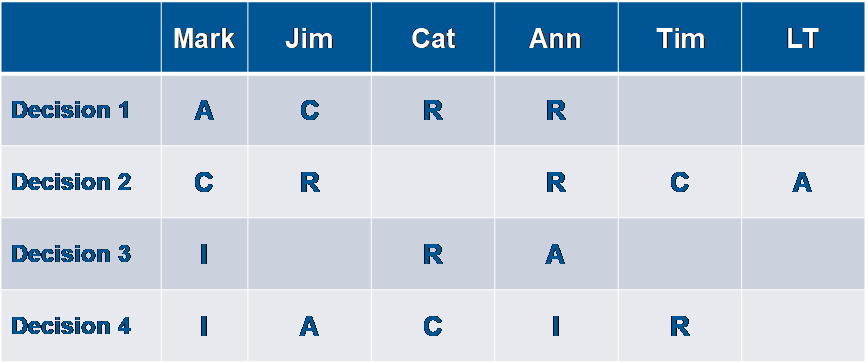One of the single biggest challenges in Category Management is getting decisions made across organizational silos. You are NOT doing Category Management if you are managing “spend” at the Business Unit level – you MUST be managing a spend category across the ENTIRE organization and herein is where the trouble begins. Business Unit leaders are accustomed to having their own budgets and P&Ls that give them free reign to make their own buying decisions. But to extract the most Value from a spend category, it is critical to use the buying power / leverage of the whole company which requires buying decisions to be made at the company level. And it is your job as a Category Management professional to herd those cats and facilitate the decision-making process.
There is a ridiculously simple tool that can help you manage the decision-making process and many of you have already used it – a RACI chart. In fact, it is so simple, you and your team are ridiculous if don’t at least give it a try ! Here is what a RACI chart is:
A Systematic and Participative Technique to:
• Identify all decisions that need to be made for your project
• Clarify roles and individual levels of participation in relation to each decision
• Develop best methods for individuals to fill these roles
RACI is an acronym for the various decision-making roles as follows:

Here is an example of a very simple RACI chart:

This is a RACI chart for a Leadership team. Across the top is each member of the team and the last column is the Leadership team as a group. The names on the top of your RACI chart will be the stakeholders that will be involved in decision making for your category. If multiple stakeholders need to be involved in one particular decision, you form a group (like the LT above) and give the group the “A” which is the ultimate decision maker. You often see committees or teams within an organization, like an IT steering committee, which are usually formed because the committee needs to make certain decisions on behalf of the organization. Along the left side of the chart are the various decisions you need your stakeholders to be involved in. If I am a stakeholder, I can look at this chart to see how I will be involved in your process – this can go a long way to illustrate the collaborative nature of the Category Management process. In addition, as a stakeholder, if I get the “A” (even as part of a team) on the most important decisions (like selecting the supplier ) then I can be comfortable relinquishing the “A” to others in less critical decisions.
The benefit of this tool is to let everyone know what their role is in the decision-making process and to use it to discuss how everyone will work together to get the right decisions made for the organization. It is also used to:
• Increase productivity
• Ensure smoother handoffs
• Increased teamwork
• Greater cross organizational effectiveness
• Streamline communication
• Increase synergies
• Reduced duplication of effort
An article in HBR, “A Good Meeting Needs a Clear Decision-Making Process” discusses the use of the RACI chart but also talks about deciding how you are going to decide. Where a group (like the LT) has the “A” for a certain decision and a consensus is required, you should define “consensus”. Will there need to be 80% agreement? Majority? Etc.? Make that decision up front and get everyone to agree before you find your team at an impasse.
Getting decisions made in a timely fashion and by the right decision makers can go a long way to ensuring the success of your Category Management process. The last thing you want is to be wandering around in the middle of your process saying, “Decisions, Decisions, Who Makes the Decisions?”
Let us know what you think and join in the conversation . . . . . . .


